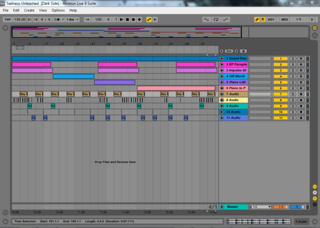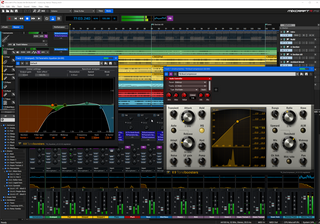
Beatmatching or pitch cue is a disc jockey technique of pitch shifting or time stretching an upcoming track to match its tempo to that of the currently playing track, and to adjust them such that the beats are synchronized—e.g. the kicks and snares in two house records hit at the same time when both records are played simultaneously. Beatmatching is a component of beatmixing which employs beatmatching combined with equalization, attention to phrasing and track selection in an attempt to make a single mix that flows together and has a good structure.

A drum kit is a collection of drums, cymbals, and sometimes other auxiliary percussion instruments set up to be played by one person. The drummer typically holds a pair of matching drumsticks or special wire or nylon brushes; and uses their feet to operate hi-hat and bass drum pedals.

MIDI is a technical standard that describes a communication protocol, digital interface, and electrical connectors that connect a wide variety of electronic musical instruments, computers, and related audio devices for playing, editing, and recording music.
In musical terminology, tempo, measured in beats per minute, is the speed or pace of a given composition, and is often also an indication of the composition's character or atmosphere. In classical music, tempo is typically indicated with an instruction at the start of a piece and, if a specific metrical pace is desired, is usually measured in beats per minute (BPM). In modern classical compositions, a "metronome mark" in beats per minute, indicating only measured speed and not any form of expression, may supplement or replace the normal tempo marking, while in modern genres like electronic dance music, tempo will typically simply be stated in BPM.

A metronome is a device that produces an audible click or other sound at a uniform interval that can be set by the user, typically in beats per minute (BPM). Metronomes may also include synchronized visual motion, such as a swinging pendulum or a blinking light. Musicians—and others including dancers, athletes, and health professionals—often practise with a metronome to improve their timing, especially the ability to maintain a steady tempo with a regular beat or pulse. Composers and conductors often use numerical metronome markings to communicate their preferred tempos to musicians preparing for a performance.
A music sequencer is a device or application software that can record, edit, or play back music, by handling note and performance information in several forms, typically CV/Gate, MIDI, or Open Sound Control, and possibly audio and automation data for digital audio workstations (DAWs) and plug-ins.

A film score is original music written specifically to accompany a film. The score comprises a number of orchestral, instrumental, or choral pieces called cues, which are timed to begin and end at specific points during the film in order to enhance the dramatic narrative and the emotional impact of the scene in question. Scores are written by one or more composers under the guidance of or in collaboration with the film's director or producer and are then most often performed by an ensemble of musicians – usually including an orchestra or band, instrumental soloists, and choir or vocalists – known as playback singers – and recorded by a sound engineer. The term is less frequently applied to music written for media such as live theatre, television and radio programs, and video games, and said music is typically referred to as either the soundtrack or incidental music.

A recording studio is a specialized facility for recording and mixing of instrumental or vocal musical performances, spoken words, and other sounds. They range in size from a small in-home project studio large enough to record a single singer-guitarist, to a large building with space for a full orchestra of 100 or more musicians. Ideally, both the recording and monitoring spaces are specially designed by an acoustician or audio engineer to achieve optimum acoustic properties.

Multitrack recording (MTR), also known as multitracking, is a method of sound recording developed in 1955 that allows for the separate recording of multiple sound sources or of sound sources recorded at different times to create a cohesive whole. Multitracking became possible in the mid-1950s when the idea of simultaneously recording different audio channels to separate discrete tracks on the same reel-to-reel tape was developed. A track was simply a different channel recorded to its own discrete area on the tape whereby their relative sequence of recorded events would be preserved, and playback would be simultaneous or synchronized.

GarageBand is a software application by Apple for macOS, iPadOS, and iOS devices that allows users to create music or podcasts. It is a lighter, amateur-oriented offshoot of Logic Pro. GarageBand was originally released for macOS in 2004 and brought to iOS in 2011. The app's music and podcast creation system enables users to create multiple tracks with software synthesizer presets, pre-made and user-created loops, an array of various effects, and voice recordings.

Soundtrack Pro is a discontinued music composing and audio editing application made by Apple Inc. It included a collection of just over 5,000 royalty free professional instrument loops and sound effects for use. The software was featured in the Logic Studio and Final Cut Studio software bundles; It was discontinued with the release of Final Cut Pro X, Motion 5, and Compressor 4.

Ableton Live is a digital audio workstation for macOS and Windows developed by the German company Ableton.

A one-man band is a musician who plays a number of instruments simultaneously using their hands, feet, limbs, and various mechanical or electronic contraptions. One-man bands also often sing while they perform.

In music, transcription is the practice of notating a piece or a sound which was previously unnotated and/or unpopular as a written music, for example, a jazz improvisation or a video game soundtrack. When a musician is tasked with creating sheet music from a recording and they write down the notes that make up the piece in music notation, it is said that they created a musical transcription of that recording. Transcription may also mean rewriting a piece of music, either solo or ensemble, for another instrument or other instruments than which it was originally intended. The Beethoven Symphonies transcribed for solo piano by Franz Liszt are an example. Transcription in this sense is sometimes called arrangement, although strictly speaking transcriptions are faithful adaptations, whereas arrangements change significant aspects of the original piece.
Foster Denki KK is an electronics company that manufactures loudspeakers and audio equipment for other companies or sells them under the trade name Fostex. It is traded on the Tokyo Stock Exchange.

Mixcraft is a digital audio workstation for Windows, developed by Acoustica since its first release in April 2004. It is as a digital audio workstation, MIDI sequencer, virtual instrument host, non-linear video arranger, and music loop recording program.
MIDI beat clock, or simply MIDI clock, is a clock signal that is broadcast via MIDI to ensure that several MIDI-enabled devices such as a synthesizer or music sequencer stay in synchronization. Clock events are sent at a rate of 24 pulses per quarter note. Those pulses are used to maintain a synchronized tempo for synthesizers that have BPM-dependent voices and also for arpeggiator synchronization.
A studio recording is any recording made in a studio, as opposed to a live recording, which is usually made in a concert venue or a theatre, with an audience attending the performance.
DrumCore is software by Sonoma Wire Works that lets songwriters and composers create drum tracks using audio loops and/or MIDI beats, fills and variations by world-class drummers across a multitude of styles. It also includes a virtual drum instrument loaded with the drummer's drumkit sounds. It has won Best Drum Software awards from the magazines Electronic Musician and Remix. DrumCore has been used by TV composers for creating music for the Survivor series as well as the drums for a recent Debbie Harry album.

This is a glossary of jazz and popular music terms that are likely to be encountered in printed popular music songbooks, fake books and vocal scores, big band scores, jazz, and rock concert reviews, and album liner notes. This glossary includes terms for musical instruments, playing or singing techniques, amplifiers, effects units, sound reinforcement equipment, and recording gear and techniques which are widely used in jazz and popular music. Most of the terms are in English, but in some cases, terms from other languages are encountered.














